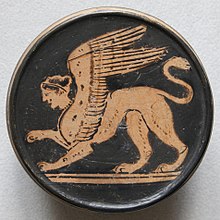
Back Sfinks Afrikaans سفنكس Arabic سفنكس ARZ স্ফিংক্স Assamese Sfinks (yunan) Azerbaijani ابوالهول AZB Сфинкс Bashkir Sphinx BAR Sphinx BCL Сфінкс Byelorussian
 | |
| Grouping | Legendary creatures |
|---|---|
| Similar entities | Griffin, Manticore, Cherub, Lamassu, Narasimha |
| Region | Persian, Egyptian, and Greek |
A sphinx (/sfɪŋks/ SFINKS; Ancient Greek: σφίγξ, pronounced [spʰíŋks]; Boeotian: φίξ, romanized: phíx, pronounced [pʰíːks]; pl. sphinxes or sphinges) is a mythical creature with the head of a human, the body of a lion, and the wings of an eagle.
In Greek tradition, the sphinx is a treacherous and merciless being with the head of a woman, the haunches of a lion, and the wings of a bird. According to Greek myth, she challenges those who encounter her to answer a riddle, and kills and eats them when they fail to solve the riddle.[1] This deadly version of a sphinx appears in the myth and drama of Oedipus.[2]
In Egyptian mythology, in contrast, the sphinx is typically depicted as a man (an androsphinx (Ancient Greek: ανδρόσφιγξ)), and is seen as a benevolent representation of strength and ferocity, usually of a pharaoh. Unlike Greek or Levantine/Mesopotamian ones, Egyptian sphinxes were not winged.
Both the Greek and Egyptian sphinxes were thought of as guardians, and statues of them often flank the entrances to temples.[3] During the Renaissance, the sphinx enjoyed a major revival in European decorative art. During this period, images of the sphinx were initially similar to the ancient Egyptian version, but when later exported to other cultures, the sphinx was often conceived of quite differently, partly due to varied translations of descriptions of the originals, and partly through the evolution of the concept as it was integrated into other cultural traditions.
However, depictions of the sphinx are generally associated with grand architectural structures, such as royal tombs or religious temples.
- ^ "Dr. J's Lecture on Oedipus and the Sphinx". People.hsc.edu. Retrieved 15 May 2014.
- ^ Kallich, Martin. "Oedipus and the Sphinx." Oedipus: Myth and Drama. N.p.: Western, 1968. N. pag. Print.
- ^ Stewart, Desmond. Pyramids and the Sphinx. [S.l.]: Newsweek, U.S., 72. Print.
© MMXXIII Rich X Search. We shall prevail. All rights reserved. Rich X Search